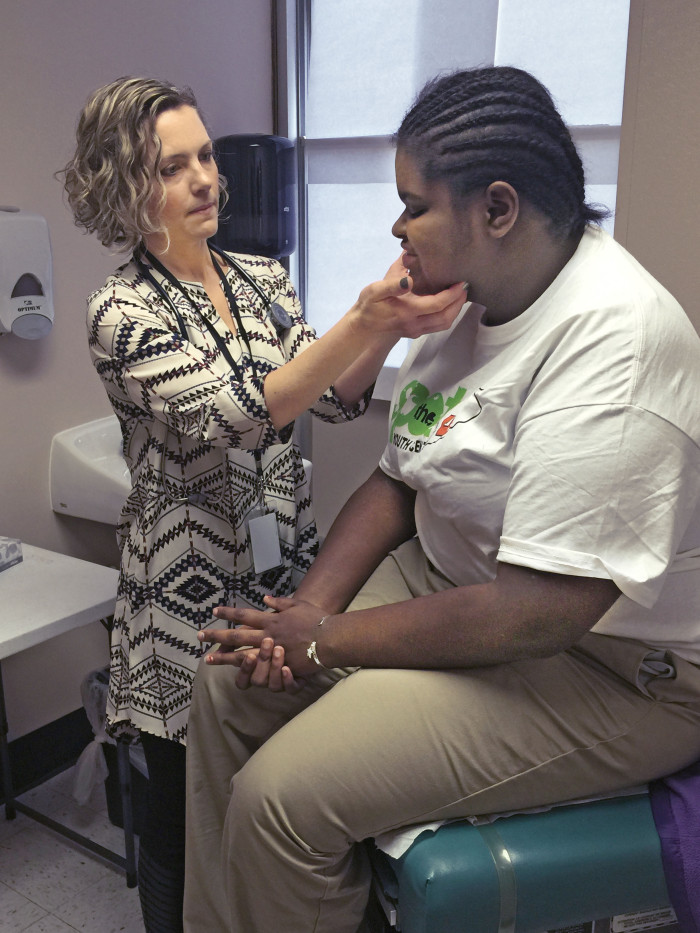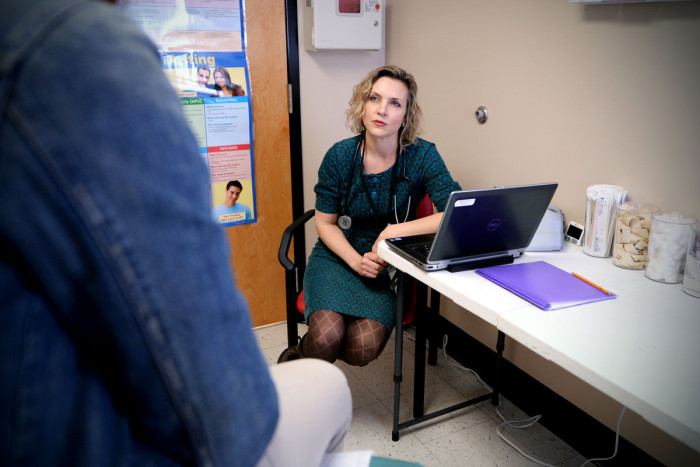School-based health clinic established at north St. Louis County high school
Started by the School of Medicine, the clinic addresses health and social services for teens
 James Byard
James ByardSarah Garwood, MD, an assistant professor of pediatrics at Washington University School of Medicine in St. Louis, discusses student health care at the newly opened clinic at Jennings Senior High School.
Lately, life is more down than up for Autumn Dixon, an 18-year-old senior at Jennings Senior High School in north St. Louis County. On top of already taxing, typical teen problems, she lives in a high-risk neighborhood where Dixon said she must navigate “negative” relationships and “complicated” methods to meet basic needs.
Inside her home, peace and quiet prove elusive. Dixon has younger siblings and cousins and, at any given time, she may babysit for a half-dozen children including infants and toddlers as well as tweens.
“Someone is always crying, fighting, needing a diaper change or asking me for something,” Dixon said. “I want to get my schoolwork done, but I always have a little shadow following me. I get behind and I’m even more stressed.”
Fortunately, Dixon has a place to decompress at Jennings high school’s on-site health and social-services clinic called Supporting Positive Opportunities for Teens, more commonly known as The SPOT at Jennings. “They understand me here,” Dixon said. “No one bugs me. They help me with my problems and encourage me to do things that relax me, like painting.”
“They” represent The SPOT’s staff, including Sarah Garwood, MD, an assistant professor of pediatrics at Washington University School of Medicine in St. Louis. This past fall, Garwood began offering students with signed parental consent forms free and confidential medical services. These include immunizations, sports physicals, routine annual exams and treatment for chronic conditions such as diabetes and asthma and illnesses like strep throat and skin rashes.
“Adolescent Medicine at Washington University approached the Jennings School District because we saw the need for health services,” said Garwood, who also sees patients at St. Louis Children’s Hospital. “We know from the medical literature that school-based health centers are an effective way to reach kids who may have unmet health and mental health needs.”
School of Medicine licensed social workers Rochelle Moore and Chardial “Chay” Samuel also help Jennings students by providing mental health counseling, budgeting tips, preventive drug and alcohol programs, job-search guidance, as well as assistance in locating community referrals for housing, legal and other quality-of-life issues.
“People at The SPOT are nice,” Dixon said. “They don’t make me feel like I’m bad because I have a lot of problems.”
Surrounded by a hallway of red lockers, an unassuming classroom door leads to The SPOT at Jennings, where space recently was modified to include two private exam rooms, counseling offices, a conference area and a quiet resting nook for students. There is also a tiny, temperature-controlled laboratory in a corner where specimens await transportation to a lab for analysis.
The Jennings student clinic is an offshoot of The SPOT in the Central West End, a Washington University drop-in clinic for youth ages 13 to 24 that opened in 2008 and has since helped nearly 12,000 patients. Garwood and physicians from the departments of pediatrics and obstetrics and gynecology oversee the free and confidential medical service at both locations.
 Kristina Sauerwein
Kristina Sauerwein“Every day at The SPOT in the Central West End, kids form a line at least an hour before we open,” Garwood said. “And almost every day, we have to turn kids away from medical care at The SPOT because it is hard for us to keep up with the need for our services.”
Both clinics receive funding from government agencies, nonprofits and private businesses.
The nonmedical portion of the Jennings clinic started in March after statistics showed the majority of youth visiting The SPOT in the Central West End came from low-income, high-risk communities in north St. Louis County. Garwood said this prompted collaboration between the School of Medicine and Jennings’ school officials, who were especially concerned about student absenteeism. With few convenient health-care and social services accessible in their neighborhoods, students had to find help in other parts of the region – a problem exacerbated by limited transportation options.
“The Jennings school-based health clinic brings The SPOT model to where we want teenagers to be – in school, completing a high school degree,” said Katie Plax, MD, founder and medical director of The SPOT. “If they stay in school, if their medical and mental health needs are met, students are more likely to succeed.”
The unrest in Ferguson also contributed to the need for the student clinic in Jennings, which borders Ferguson. “When Michael Brown was shot, we saw a lot of hurt and anger among the youth we serve at The SPOT in the Central West End,” said Plax, the Ferring Family Chair of Pediatrics at St. Louis Children’s Hospital and the School of Medicine. “We wanted to respond in a way that would make a difference. The SPOT at Jennings is an important response to Ferguson, a recommendation of the Ferguson Commission and a model of community partnership to change the lives of children and youth.”
Additionally, in October, the School of Medicine received a three-year, $60,000 grant to work with the Jennings district to understand how trauma can negatively affect a child’s ability to learn in the classroom. Stressful situations familiar to many Jennings residents such as poverty, violence and substance abuse can increase student behavioral problems, thwart development and incapacitate the ability to perform necessary, day-to-day activities.
The grant – given by the Missouri Foundation for Health and the American Academy of Pediatrics – supports a whole-child approach to discipline and education by focusing on how trauma impacts a child physically, mentally and developmentally. “There is a toxicity to poverty that can lead to stressful and traumatic experiences,” said Jennings Superintendent Tiffany Anderson, who has received national recognition for overhauling the once-unaccredited school district. “When students have unmet basic needs or do not know how those basic needs will be met daily, behaviors that are symptomatic of being in trauma may be viewed.”
So far this school year, the focus is on training staff – every teacher, secretary and custodian – to understand “the story behind the behavior,” Anderson said. “The whole idea behind a trauma-informed school district is that everybody is trained so that when they see a behavior, they seek to understand the story first. That changes what our response might be.”
The Jennings district also has posted a job opening for a therapeutic teacher who will be trained by Washington University specialists in trauma as well as mental health. “Transitioning students to the therapeutic teacher, as needed, allows the child to be in a safe, loving and instructional environment that will help teach that child how to function,” said Anderson, who is leaving the district at the end of the school year for a position in Kansas. “Ultimately, suspending children out of school is not productive. It’s just not. And it’s an ongoing cycle – that student misses school and is disconnected. That is not good.”
Besides working through traumas, students visiting The SPOT at Jennings also can seek reproductive health care, and girls can receive medication to regulate menstrual periods and reduce cramping.
After a recent exam, Dixon said she felt “lighter, like I can fix some of my problems. I’m feeling more upbeat than down.”
 James Byard
James Byard






